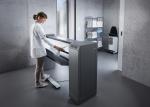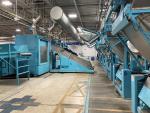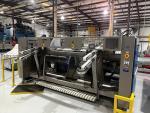CHICAGO — Factors such as quality, efficiency, safety and labor issues have pushed technological advances in industrial laundry technology in recent years.
These upgrades and advancements have been researched, tested and implemented by manufacturers of equipment throughout laundry processing facilities.
That includes the final phase of the operation: finishing.
American Laundry News reached out to operators and finishing equipment manufacturers to learn about recent advancements and the benefits they provide in the processing of goods.
What are some of the most recent upgrades in finishing equipment?
EDWARD MCCAULEY, president and CEO of United Hospital Services and a member of the American Laundry News editorial advisory board: The biggest advancement in my mind is the ability to add a QC (quality control) camera. These cameras can pull out stains, mends and other things such as tape and even misfolded goods.
ED KIREJCZYK, president of Sea-lion America Company: Our finishing systems’ automatic spreader/feeder has bionic spreading robot arms that are driven by servo motors to keep linens in the specified feeding position making difficult items (such as fitted sheets) easier to process.
The serpentine ironing method of the high-speed serpentine flatwork ironer finishes both sides of linen for the highest quality results.
Finally, the intelligent control system on the high-speed flatwork folder selects the corresponding folding program according to different types of linen to complete the folding.
PATRICK GITTARD, marketing manager for JENSEN USA Inc.: Express Pro is a groundbreaking product, the first cornerless feeder that offers true leading-edge quality on all linen categories of large-piece linen, even table linen.
Like the other feeders in JENSEN’s Express range, cornerless feeding doubles the capacity per operator hour, and it comes with either two or three feeding stations. Now, thanks to the integration of a mechanical transfer beam, it is possible to achieve this elevated production capacity on heavier and larger linen, without sacrificing efficiency or quality.
The Kalor is the latest innovation in JENSEN ironing technology, combining the best of fixed and flexible chests, incorporating what is referred to as a semi-flexible chest design. As the design is very similar to a standard flexible chest, it offers the same excellent evaporation performance.
However, the Kalor utilizes a thicker inner chest plate, which makes it more optimal for processing linen with EKG buttons. Furthermore, the addition of a large diameter heated gap piece further improves the evaporation capacity, effectively adding additional ironing capacity with minimal additional floor space.
AL ADCOCK, vice president of sales and marketing for B&C Technologies: With labor so difficult to find and retain, one of the best investments for ironing is a built-in feeding system. If you are thinking about adding an ironer or replacing your current ironing system, labor reduction can be incorporated which can reduce the overall operational cost of the equipment over its lifetime.
PAULO ROCHA, head of service U.S., regional service director NAM Region, Miele Professional: Impeccable fabric finishing is a hallmark of excellence in the dynamic world of textile care. Manufacturers industry-wide are responding with upgrades to meet the evolving needs of operators.
Flatwork ironers are needed in a variety of applications and environments, from hotels and hospitals to commercial laundries. Offering different-sized ironers provides higher throughput and more efficient work processes.
Commercial flatwork ironers should be able to handle a wide range of fabric types, from delicate to heavy-duty materials. This versatility helps businesses improve the output of finished products.
Operator safety is a top priority, and ironers should be designed with safety features to help prevent any potential accidents or injuries. Ergonomic design ensures that operators can work comfortably, minimizing strain.
CAROL TYLER, director of marketing for Chicago Dryer Company: Automation in the finishing department is becoming more desirable.
For instance, automated towel feeding into small-piece folders using both AI (artificial intelligence) and vision technology is beginning to find its way into laundries.
How do these upgrades work within the normal finishing process?
MCCAULEY: The QC cameras fit on the feed table of the folder/cross folder. The sheet comes up the feed table and is photographed. The photograph is compared to a setting that you input into the camera and is either accepted as a good sheet or rejected.
KIREJCZYK: The material conveying system on the high-speed serpentine flatwork ironer uses wide-width spindle belts to avoid the difficult-to-solve swimming phenomenon of wide-width canvases during processing.
The high-speed flatwork folder’s fourth and fifth folds adopt forward and reverse control, whereby fold quality is not affected by the thickness and material of the linen.
GITTARD: Due to the high capacity of the Express Pro, it typically is equipped with a high-capacity ironer. It is also possible to connect to cornerless remote feeding solutions.
Kalor operates like a standard ironer.
ROCHA: Most of these upgrades should seamlessly integrate into the normal finishing process by optimizing key aspects of operation. By enhancing efficiency, reducing energy consumption and improving overall performance, they facilitate a smoother workflow and elevate the quality of finished products.
While some upgrades may require investment in new machinery—particularly for operators using older, outdated models—the long-term benefits in terms of productivity and cost savings justify the transition and cost.
Ultimately, these advancements are engineered to ensure consistent, superior results for commercial laundry operators.
TYLER: An automated towel feeder automatically accepts the towels from a delivery system and picks, shakes, orients and feeds the towels into a small-piece folder.
The system has to evaluate the towel and make decisions if the piece is to be accepted or rejected and if accepted, determine where to pick up the towel to initiate the feeding process.
How do these benefit laundry operators?
MCCAULEY: The good thing about QC cameras is they look at the sheet in dry condition as opposed to manually looking at the sheets up front by the feeders when the sheets are damp.
So many stains only show up after the sheets are dry like some medicinal and oil-based stains. If you have two or more quality levels of sheets, the cameras are also perfect for this because you can have an almost infinite number of formulas to get to the quality level that you are seeking.
KIREJCZYK: Fitted with dual stackers, the intelligent control on the high-speed flatwork folder can automatically sort different linen sizes.
GITTARD: Before, laundry operators had to choose between speed and quality. Now, even when feeding table linen or king-size sheets, with Express Pro, it is possible to double the capacity per operator, meaning major manpower savings.
The Kalor offers added evaporation capacity resulting in faster possible ironing speeds, and for healthcare laundries that process linen with EKG buttons, there is an additional peace of mind from the thicker inner chest plate.
ADCOCK: Without a built-in feeder, you’ll need to hand-feed the machine, which usually requires two operators for good results, or purchase a stand-alone feeder. More operators mean more labor costs while a separate feeding system will have the added cost of another machine, plus the floor space required to install it.
A built-in feeder, which doesn’t add to the overall footprint of the machine, is the simplest and most cost-effective solution as built-in feeders are lower in price than you’ll pay in salary for an employee and thus offer a quick return on investment (well less than one year).
ROCHA: These upgrades offer laundry operators a multitude of benefits.
The higher throughput and streamlined workflow enable businesses to meet increased demand without compromising quality. That translates to improved operational efficiency and stronger customer satisfaction.
The ability of these enhanced commercial flatwork ironers to handle different fabric types ensures that operators can confidently process everything from delicate textiles to heavy-duty fabrics with one machine without compromising on performance or garment integrity. Laundry businesses can, in turn, expand their service offerings to meet the needs of a wider array of clients, improving competitive market position and revenue potential.
Safety mechanisms such as automatic shut-off and protective guards help to keep operators safe, providing peace of mind and maintaining a secure and positive working environment.
TYLER: Automation, by definition, is the use of technology to perform tasks with reduced human assistance.
The use of a system like this will reduce labor exposure in this area of the laundry therefore allowing the reallocation of valuable labor assets to other important tasks.
Check back Thursday for the conclusion on how operators can best make use of upgrades, and what’s coming in finishing enhancements.
Have a question or comment? E-mail our editor Matt Poe at [email protected].





